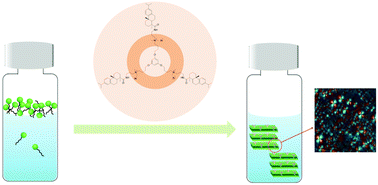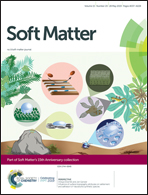Viscoelastic lyotropic liquid crystals formed in a bio-based trimeric surfactant system†
Abstract
Exploring the self-assembly of oligomeric surfactants is expected to bridge the gap between conventional and polymeric surfactants. Using the natural resource rosin as the starting material, a bio-based star-shaped trimeric quaternary ammonium surfactant (abbreviated tri-R-4-Phe) was synthesized. With three bulky dehydroabietic acid units in the hydrophobic group, tri-R-4-Phe has a molecular weight of 1684.9 and shows strong affinity towards both water and nonpolar organic compounds. In the presence of tri-R-4-Phe, C12EO3 was able to form lamellar lyotropic liquid crystals over a wide concentration range in water. The tri-R-4-Phe/C12EO3/water tertiary system was investigated by polarizing optical microscopy (POM), small angle X-ray scattering (SAXS) and rheological measurements. The investigated samples with different formulations all showed strong viscoelasticity, and the viscosity increased with the surfactant content. All samples showed interesting shear banding phenomena due to the shear induced mesoscale phase transition in tri-R-4-Phe/C12EO3/water systems. The present work reveals the unique behaviour of trimeric surfactant involved LLC systems and the result may be helpful in investigating delicate molecular self-assembly using natural resources.



 Please wait while we load your content...
Please wait while we load your content...